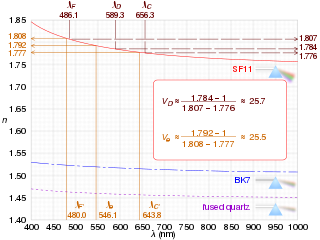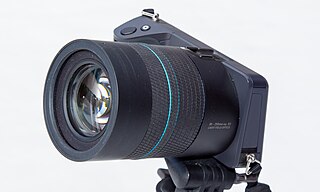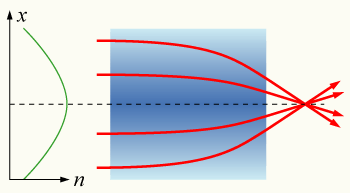
In optics and lens design, the Abbe number, also known as the V-number or constringence of a transparent material, is an approximate measure of the material's dispersion, with high values of V indicating low dispersion. It is named after Ernst Abbe (1840–1905), the German physicist who defined it. The term V-number should not be confused with the normalized frequency in fibers.

For many cameras, depth of field (DOF) is the distance between the nearest and the farthest objects that are in acceptably sharp focus in an image. The depth of field can be calculated based on focal length, distance to subject, the acceptable circle of confusion size, and aperture. A particular depth of field may be chosen for technical or artistic purposes. Limitations of depth of field can sometimes be overcome with various techniques/equipment.

In optics, the refractive index of a material is a dimensionless number that describes how fast light travels through the material. It is defined as
Optics is the branch of physics which involves the behavior and properties of light, including its interactions with matter and the construction of instruments that use or detect it. Optics usually describes the behavior of visible, ultraviolet, and infrared light. Because light is an electromagnetic wave, other forms of electromagnetic radiation such as X-rays, microwaves, and radio waves exhibit similar properties.

Gradient-index (GRIN) optics is the branch of optics covering optical effects produced by a gradient of the refractive index of a material. Such gradual variation can be used to produce lenses with flat surfaces, or lenses that do not have the aberrations typical of traditional spherical lenses. Gradient-index lenses may have a refraction gradient that is spherical, axial, or radial.

A light field camera, also known as plenoptic camera, is a camera which captures information about the light field emanating from a scene; that is, the intensity of light in a scene, and also the direction that the light rays are traveling in space. This contrasts with conventional cameras, which record only light intensity.

A lenticular lens is an array of lenses, designed so that when viewed from slightly different angles, different parts of the image underneath is shown. The most common example is the lenses used in lenticular printing, where the technology is used to give an illusion of depth, or to make images that appear to change or move as the image is viewed from different angles.

Nippon Sheet Glass Co., Ltd. is a Japanese glass manufacturing company. In 2006 it purchased Pilkington of the United Kingdom. This makes NSG/Pilkington one of the four largest glass companies in the world alongside another Japanese company Asahi Glass, Saint-Gobain, and Guardian Industries.
OGLE-2005-BLG-169L is a dim and distant magnitude 20 galactic bulge star located about 2,700 parsecs away in the constellation Sagittarius. If it is a main sequence star, then it is most likely a red dwarf with about half of the mass of the Sun. Other possibilities are a white dwarf star, or a neutron star or black hole.
Optical lens design is the process of designing a lens to meet a set of performance requirements and constraints, including cost and manufacturing limitations. Parameters include surface profile types, as well as radius of curvature, distance to the next surface, material type and optionally tilt and decenter. The process is computationally intensive, using ray tracing or other techniques to model how the lens affects light that passes through it.
Integral imaging is an autostereoscopic and multiscopic three-dimensional imaging technique that captures and reproduces a light field by using a two-dimensional array of microlenses, sometimes called a fly's-eye lens, normally without the aid of a larger overall objective or viewing lens. In capture mode, in which a film or detector is coupled to the microlens array, each microlens allows an image of the subject as seen from the viewpoint of that lens's location to be acquired. In reproduction mode, in which an object or source array is coupled to the microlens array, each microlens allows each observing eye to see only the area of the associated micro-image containing the portion of the subject that would have been visible through that space from that eye's location. The optical geometry can perhaps be visualized more easily by substituting pinholes for the microlenses, as has actually been done for some demonstrations and special applications.
OGLE-2005-BLG-169Lb is an extrasolar planet located approximately 2700 parsecs away in the constellation of Sagittarius, orbiting the star OGLE-2005-BLG-169L. This planet was discovered by the OGLE project using the gravitational microlensing method. Based on a most likely mass for the host star of 0.49 solar mass (M☉), the planet has a mass of 13 times that of Earth (M⊕). Its mass and estimated temperature are close to those of Uranus. It is speculated that this planet may either be an ice giant like Uranus, or a "naked super-Earth" with a solid icy or rocky surface.
The KAF-10500 is a CCD imaging sensor designed by US photographic company Eastman Kodak. In September 2006 it was announced that the sensor was to be used in the Leica M8 digital rangefinder camera, having been specifically designed for this application. Its size is 18x27 mm (APS-H) and it has 10.3 million pixels of size 6.8 μm. Compared to 35mm film, it has a 1.33 crop factor. It is calibrated for an ISO sensitivity range of 160–2500.
Ioannis G. Pallikaris is a Greek ophthalmologist who in 1989 performed the first LASIK procedure on a human eye. Pallikaris also developed Epi-LASIK.

In digital photography, the image sensor format is the shape and size of the image sensor.

Hemispherical photography, also known as canopy photography, is a technique to estimate solar radiation and characterize plant canopy geometry using photographs taken looking upward through an extreme wide-angle lens or a fisheye lens. Typically, the viewing angle approaches or equals 180-degrees, such that all sky directions are simultaneously visible. The resulting photographs record the geometry of visible sky, or conversely the geometry of sky obstruction by plant canopies or other near-ground features. This geometry can be measured precisely and used to calculate solar radiation transmitted through plant canopies, as well as to estimate aspects of canopy structure such as leaf area index. Detailed treatments of field and analytical methodology have been provided by Paul Rich and Robert Pearcy (1989).

A microlens is a small lens, generally with a diameter less than a millimetre (mm) and often as small as 10 micrometres (µm). The small sizes of the lenses means that a simple design can give good optical quality but sometimes unwanted effects arise due to optical diffraction at the small features. A typical microlens may be a single element with one plane surface and one spherical convex surface to refract the light. Because micro-lenses are so small, the substrate that supports them is usually thicker than the lens and this has to be taken into account in the design. More sophisticated lenses may use aspherical surfaces and others may use several layers of optical material to achieve their design performance.
MACHO-98-BLG-35 was a gravitational microlensing event that occurred in July 1998 in the constellation Sagittarius. The red dwarf star causing the lens may have a planet, according to one study.
A flat lens is a lens whose flat shape allows it to provide distortion-free imaging, potentially with arbitrarily-large apertures. The term is also used to refer to other lenses that provide a negative index of refraction. Flat lenses require a refractive index close to −1 over a broad angular range. In recent years, flat lenses based on metasurfaces were also demonstrated.
The aim of an accurate intraocular lens power calculation is to provide an intraocular lens (IOL) that fits the specific needs and desires of the individual patient. The development of better instrumentation for measuring the eye's axial length (AL) and the use of more precise mathematical formulas to perform the appropriate calculations have significantly improved the accuracy with which the surgeon determines the IOL power.










